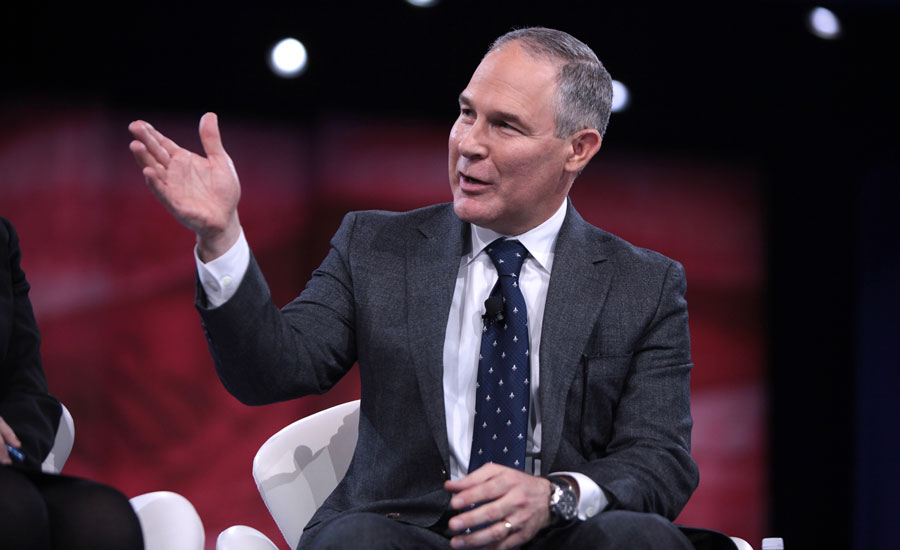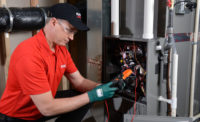One man’s planet-threatening climate change is another man’s commerce-stifling overregulation. And, so it comes to pass that former President Barack Obama’s Clean Power Plan, which was introduced in August 2015 in an attempt to limit greenhouse gas emissions and slow climate change, is being brushed aside by President Donald Trump.
On March 28, Trump issued the Energy Independence executive order, which directs the U.S. Environmental Protection Agency (EPA) to begin reviewing — and presumably weaken the provisions of — the Clean Power Plan. The order is also designed to decrease the nation’s dependence on imported fuels, mainly by helping revive the coal industry.
The Energy Independence executive order directs agencies responsible for regulating domestic energy production to submit plans to the White House that will identify and propose measures to revise or rescind regulatory barriers that impede progress toward energy independence. It further directs EPA Administrator, Scott Pruitt, and Secretary of the Interior, Ryan Zinke, to review and, if necessary, revise or rescind regulations that place unnecessary burdens on coal-fired electric utilities, coal miners, and oil and gas producers.
For such change to occur, the EPA would need to go through a formal rulemaking process. Additionally, the Clean Power Plan may be exempt from this process as it was almost immediately frozen by state challenges and a Supreme Court order following Trump’s election.
THE FUTURE OF THE PARIS AGREEMENT
It is not yet known if the Energy Independence executive order indicates the U.S. will withdraw from the Paris Climate Agreement and its planned phasedown of hydrofluorocarbons (HFCs). However, as the EPA notes, it changes or rescinds several of Obama’s executive orders and policies related to climate change. These changes include recalculating an economic metric known as the social cost of carbon (SCC) and eliminating the need for federal agencies to consider climate change when analyzing environmental permits.
Pruitt said the order will help the U.S. to be “both pro-jobs and pro-environment.”
However, Erik Solheim, executive director of the United Nations Environment Programme (UNEP), cautioned, “This is not the time for any country to change course on the very serious and very real threat of climate change. The science tells us that we need bolder, more ambitious commitments.”
Kevin Fay, executive director of the Alliance for Responsible Atmospheric Policy, said, from the HVACR industry’s perspective, it’s important to note that the executive order did not specifically address industry’s ongoing effort to phase down HFCs.
“The alliance is working to communicate the industry’s support for responsible policy mechanisms, including full funding of the Montreal Protocol on the basis that doing so closely aligns with the president’s goals to strengthen the U.S. economy and create jobs for American workers,” Fay told The NEWS.
REALIZED EFFICIENCY
Barton C. James, senior vice president of government relations, ACCA, said the organization is excited to see an effort from the government to restore commonsense regulations. However, he said the proof or value of any executive order is always in its implementation, and the goal of the country’s energy policy should be to promote realized efficiency that results in savings for consumers and maximizes the use of resources.
James said that although the U.S. economy depends on the HVACR systems that make modern medicine possible, keep food fresh, and ensure information technology systems are operational, the industry continues to be held back by an energy policy that has no regard for the consequences of improperly installed systems.
“ACCA is committed to restoring sound energy policy,” he said. “This includes helping Congress and the Trump administration understand the importance of consumer education and incentives for quality installation policies and programs, so we can take full advantage of our nation’s most abundant energy resource: energy efficiency.
“For the last eight years, our national energy policy was transformed into an ideologically driven environmental policy aimed at equipment manufacturers, instead of installations,” James added. “These policies resulted in the development of cutting-edge energy-efficient technologies that are not delivering the promised energy savings. Until we shift our focus to realized efficiency, we will continue to undermine our national energy-efficiency initiatives.”
Pruitt said the American people deserve an EPA that works to protect both the environment and enables a growing economy.
“Our EPA puts America first,” he said. “President Trump has a clear vision to create jobs, and his vision is completely compatible with a clean and healthy environment. By taking these actions, the EPA is returning the agency to its core mission of protecting public health while also being pro-energy independent.”
RETHINKING THE SOCIAL COST OF CARBON
The Air-Conditioning, Heating, and Refrigeration Institute (AHRI) applauded Trump’s decision to address the SCC analysis in federal rulemakings. AHRI had requested in January that the president take this step to improve the process through which federal energy-efficiency rules are determined to be economically justified. AHRI said the SCC metric utilized by the previous administration was developed through a closed-door, nontransparent process by an interagency working group that lacked objectivity.
“This new administration promised to aid manufacturers that have had to endure an unprecedented number of regulations that increased the cost of doing business in America, harmed consumers, stifled job creation, and hurt our global competitiveness,” said Stephen Yurek, president and CEO, AHRI. “To date, the SCC has been used as a basis for cost-benefit analyses to validate unreasonable efficiency regulations — without stakeholder input on the estimates — and we believe its use was a violation of agency responsibilities under the Administrative Procedures Act.”
Yurek added that several of the rules affecting AHRI member companies that have been issued using these analyses have not adequately considered higher equipment costs for consumers or energy, production costs, and job losses for manufacturers.
“Through this action, it appears that these important regulatory effects will be analyzed in a more balanced and realistic way in future rulemakings,” he said.
JUST THE START OF THE PROCESS
Mark Menzer, director of public affairs, Danfoss, said it’s important to keep Trump’s executive order in perspective, as executive orders only serve to start processes and do not change laws or regulations by themselves.
“Many of these actions require a time-consuming process of deregulating, which can be as cumbersome as the original regulation,” Menzer noted.
According to Menzer, this executive order is not expected to have any effect on the ongoing phasedown of refrigerants; however, it could impact HVACR equipment in a number of ways.
The first impact on HVACR could be on the cost of electricity. The expectation of higher electricity prices in the future helps drive the push to higher-efficiency HVACR equipment. This order asks for a review of the Clean Power Plan, and although the plan has not yet been enforced, many states have been moving ahead to reduce the use of coal and raise the efficiency of power plants.
“There is no reason to believe that those states will suddenly reverse direction,” Menzer said. “Thus, I expect the impact of this executive order on electricity prices to be slight. Not only is coal a shrinking proportion of electric generation, but states’ renewable resource portfolios will favor solar, wind, and other renewables, further diminishing coal’s share. Ratepayers should still expect that electricity prices will rise in the future, particularly as utilities upgrade their distribution infrastructures to meet the needs of a smart grid.”
Like Yurek, Menzer also cited the executive order’s review of the SCC provision. According to Menzer, the SCC is an attempt to monetize the effect that human-emitted carbon — including CO2 — has on the environment. However, arriving at a true societal cost is difficult, and the estimate of the magnitude of the SCC varies greatly.
“Significantly, SCC has been used by the U.S. Department of Energy [DOE] in developing minimum efficiency rules for HVACR and other equipment,” Menzer noted. “It may have been used to justify higher minimum efficiencies than would otherwise have been proposed, although the DOE process is not transparent enough to know that for sure.
“It is clear, though, that a lower price for SCC, or no DOE consideration of SCC at all, could result in minimal increases in minimum efficiencies in the future,” Menzer added.
Finally, the executive order nixes a 2013 executive order, “Preparing the U.S. for the Impact of Climate Change,” which, along with other prioritized efforts, was designed to monitor and measure the effects of climate change as well as protect seacoasts, water resources, and military operations.
“This might not have a direct impact on the HVACR industry, but it separates the U.S. government approach from that of industry and most other governments,” Menzer noted.
Menzer reiterated that despite the potential changes it encompasses, the Energy Independence executive order only starts a long process.
“With so many government agency senior officials still to be named and confirmed, it will likely be some time before consequences of this order are apparent,” he said.
PRUITT: ‘NO MORE REGULATORY ASSAULT’
Here is an excerpt of remarks made by Scott Pruitt, U.S. Environmental Protection Agency (EPA) Administrator, at the signing of the Energy Independence executive order by President Donald Trump.
“As we gather here today, the president is setting a new journey, a new pathway forward on how we are going to do business in this country, with respect to energy and the environment.
“Number one, the president, by his signature today, is rejecting the narrative that this country cannot be both pro-energy and pro-environment. We have done that throughout our history. We can actually achieve good jobs, good growth, and pro-energy policies at the same time as protecting our environment. The president is sending that message by his signature today on this executive order.
“But, number two, he’s also setting a pathway forward, a journey to say that we are no longer going to have regulatory assault on any given sector of our economy. That is going to end by the signing of this executive order. We are not going to allow regulations here at the EPA to pick winners and losers. And that is going to be very important as we chart the pathway forward.
“But, the third thing is that we are going to play within the rules. The EPA should pass rules that are within the framework that Congress has established. That sounds pretty novel, but that is exactly what should occur. We shouldn’t re-imagine our authority to pick winners and losers. We are going to provide regulatory certainty. So, the president is setting a new pathway forward that is going to literally make sure that we transform our economy, grow jobs, and also protect our environment. Today’s an exciting day, and I appreciate his leadership.”
Publication date: 5/1/2017
Want more HVAC industry news and information? Join The NEWS on Facebook, Twitter, and LinkedIn today!




